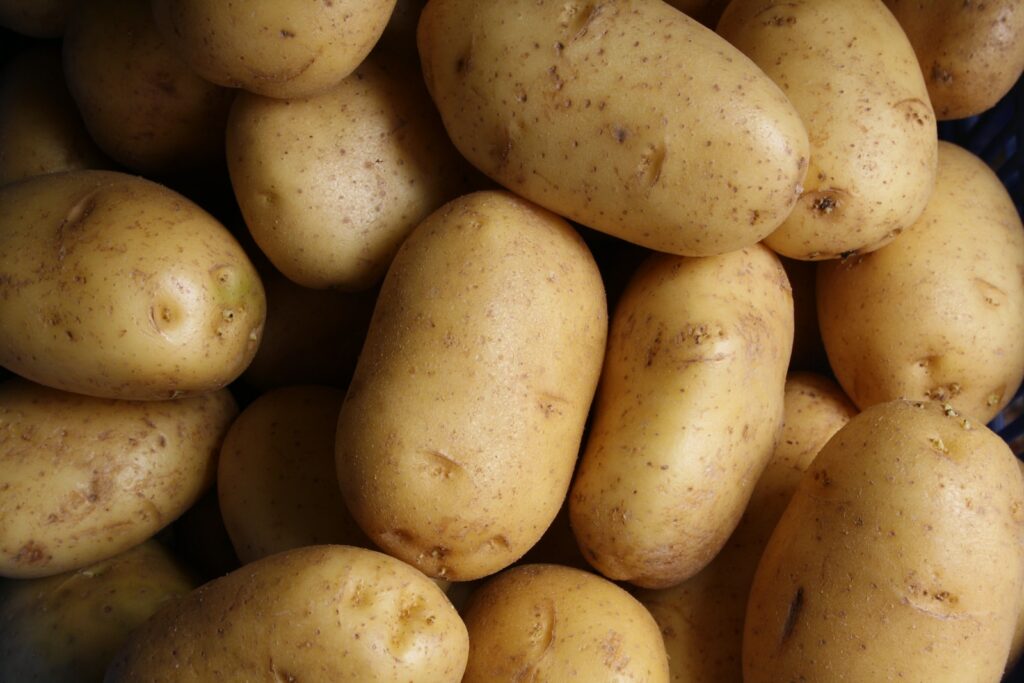
Potatoes are a staple food in many households around the world. They are versatile and can be cooked in a variety of ways, from mashed to roasted. However, not everyone knows what a potato plant looks like. In this article, we will explore the appearance of potato plants and provide a detailed description of their features.
Potato plants are members of the Solanaceae family, which includes other plants such as tomatoes and peppers. They are herbaceous perennials that grow up to 4 feet tall and have a spread of 2-3 feet. The stems of potato plants are thick and sturdy, with leaves that grow alternately on the stem. The leaves are compound and consist of several leaflets that are oval-shaped with pointed tips.
The flowers of potato plants are usually white or pink and grow in clusters. They have five petals and a yellow center. The fruit produced by the plant is a small, green berry that contains small seeds. Potato plants are typically grown from seed potatoes, which are small pieces of the potato tuber that are planted in the soil. With this knowledge, readers will be able to identify potato plants with ease.
Table of Contents
Understanding Potato Plants
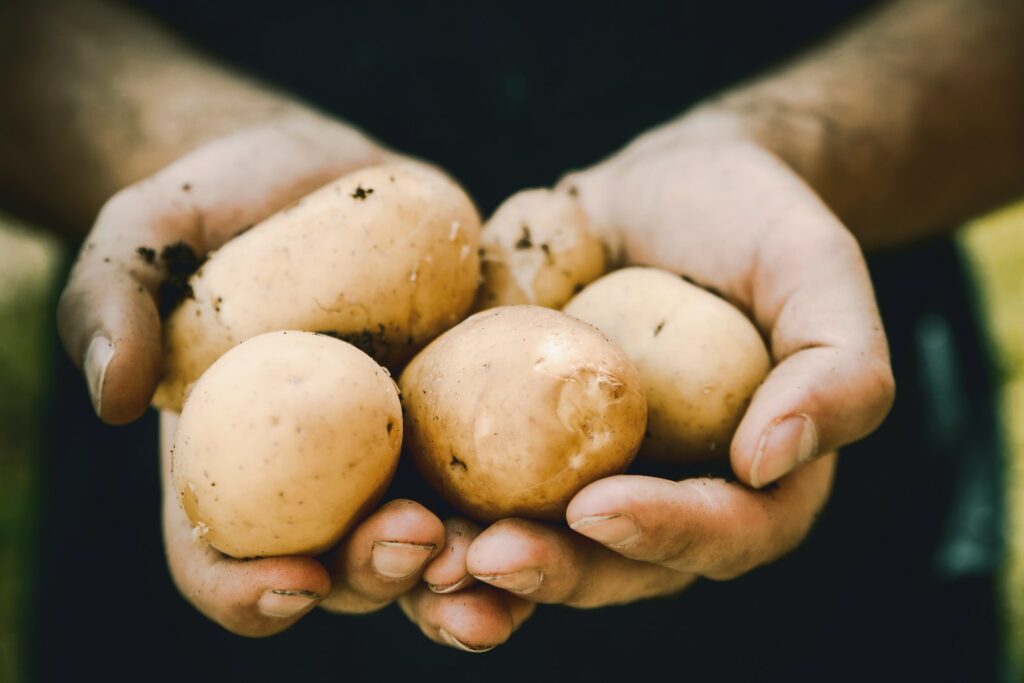
Potato plants, or Solanum tuberosum, are members of the nightshade family and are grown for their starchy tubers. The potato is one of the most widely cultivated vegetables in the world, and it is a staple food in many countries.
Potato plants are herbaceous perennials that grow to a height of 2-4 feet. They have compound leaves that are arranged in an alternate pattern along the stem. The leaves are divided into leaflets that are ovate in shape and have a smooth margin.
Potato plants produce flowers in late spring or early summer. The flowers are white or pink in color and are arranged in clusters on the stem. The fruit of the potato plant is a small green berry that contains many seeds.
The most important part of the potato plant is its tubers. The tubers are the swollen underground stems of the plant that store starches and other nutrients. The tubers can vary in size and shape, depending on the variety of potato.
Potato plants require well-drained soil and full sun to grow. They are typically planted in the spring and harvested in the fall. The plants are susceptible to a number of diseases and pests, including blight, aphids, and potato beetles.
In summary, potato plants are herbaceous perennials that produce starchy tubers. They require well-drained soil and full sun to grow and are susceptible to a number of diseases and pests.
Stages of Potato Plant Growth
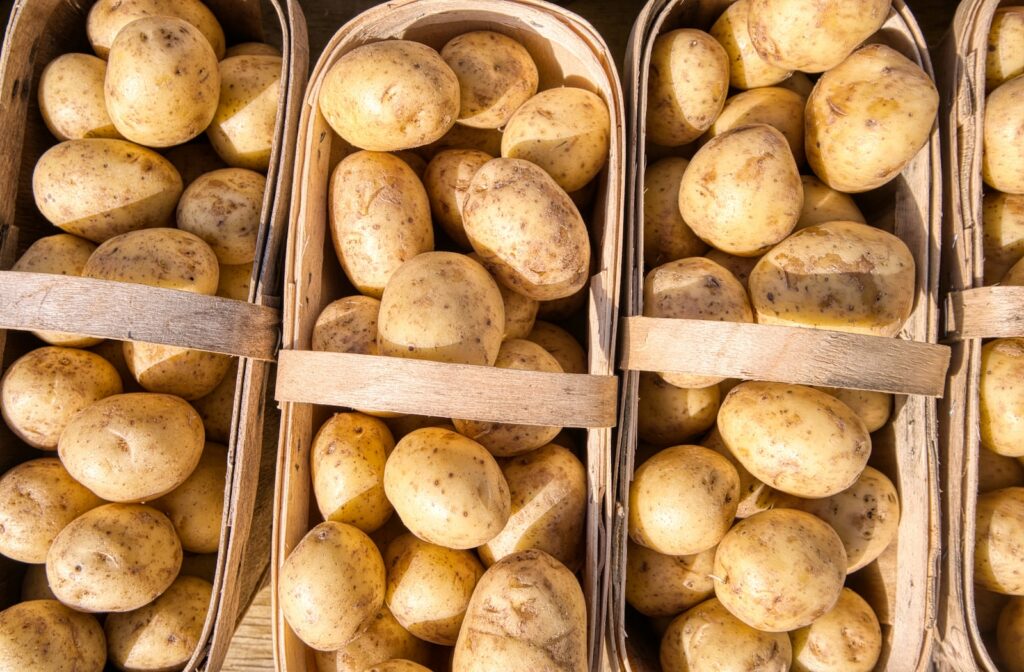
Early Development
Potato plants emerge from the soil as small, green shoots. At this stage, they are vulnerable to frost and other environmental factors. As the plant grows, it develops a dense mat of roots beneath the soil surface to support its increasing size and nutrient requirements.
Medium-Sized Plant
As the plant grows, it develops a series of leaves that are arranged in a spiral pattern around the stem. At this stage, the plant is still relatively small and may be susceptible to pests and diseases. However, it is also capable of withstanding some environmental stress and can continue to grow even in adverse conditions.
Fully Grown Plant
The fully grown potato plant is a robust, bushy plant that can reach up to 3 feet in height. It has a thick stem and a large number of leaves that help it to capture sunlight and convert it into energy. At this stage, the plant is less vulnerable to pests and diseases and is more capable of withstanding environmental stress.
Flowering Stage
The potato plant enters the flowering stage when it produces small white or pink flowers. These flowers are attractive to pollinators and can help to increase the yield of the potato crop. However, they also signal the beginning of the plant’s die back phase, which is when the plant begins to prepare for harvest.
Harvest Ready
When the potato plant is ready for harvest, it will begin to die back and turn yellow. At this stage, the tubers are fully mature and can be harvested for consumption or storage. The timing of the harvest is critical, as leaving the potatoes in the ground for too long can result in spoilage or damage.
In summary, the potato plant goes through several stages of growth, from emerging as a small shoot to reaching full maturity and producing flowers. Understanding these stages can help growers to optimize their crop yield and ensure a successful harvest.
Potato Plant Features
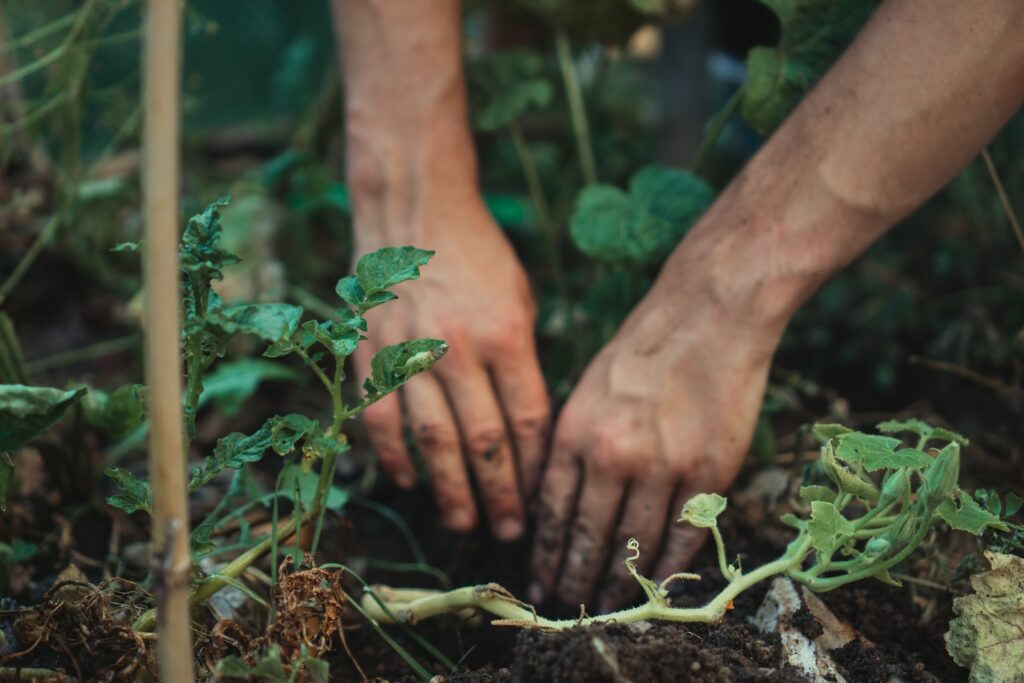
Potato plants are herbaceous perennials that belong to the Solanaceae family. They grow up to 100 cm tall and have a distinctive appearance. This section will discuss the various features of potato plants, including leaves, flowers, and tubers.
Leaves
Potato plants have compound leaves that are spirally arranged on the stem. Each leaf is made up of several leaflets that are oval-shaped and can grow up to 10 cm long. The terminal leaflet is usually larger than the other leaflets. The leaves are green and can turn yellow if the plant is stressed.
Flowers
Potato plants produce small, purple flowers that have fused petals and yellow stamens. The flowers are produced in clusters and can be found at the end of the stem. The flowers are not particularly showy and are often overlooked.
Tubers
The most well-known feature of potato plants is their tubers. The tubers grow underground and are the part of the plant that is harvested for food. The tubers can vary in size and shape, but are usually oval or elongated. They have eyes, which are the small buds on the surface of the tuber. When the eyes sprout, they produce stolons, which are the long, thin stems that grow out of the tuber and produce new plants.
Overall, potato plants are easily recognizable due to their compound leaves, purple flowers, and tubers. While the plant itself is not particularly showy, it is an important crop that is grown worldwide. It is worth noting that the leaves and stems of the potato plant are poisonous, and the plant produces a small, poisonous berry.
Cultivating Potatoes
Planting
To grow potatoes, one must first choose a suitable garden plot with well-drained soil and plenty of sunlight. Planting should be done in the spring, after the last frost. Seed potatoes should be cut into pieces with at least one “eye” each, and allowed to dry for a day or two before planting. The pieces should be planted about 4 inches deep and 12 inches apart, with the eyes facing up.
Growing
Potatoes require consistent watering and soil moisture. As the plants grow, they should be hilled, or covered with soil, to protect the developing tubers from sunlight. This can be done several times throughout the growing season. Fertilizer can also be applied periodically to encourage growth.
Harvesting
Potatoes are typically ready to harvest in the fall, after the plants have died back. The tubers should be dug up carefully to avoid damaging them. New potatoes can be harvested earlier, when the plants are still green and the tubers are small. Once harvested, the potatoes should be allowed to dry in a cool, dark place for a week or two before being stored.
Overall, cultivating potatoes can be a rewarding experience for gardeners. With proper planting, growing, and harvesting techniques, one can enjoy a bountiful harvest of delicious tubers.
Potato Varieties
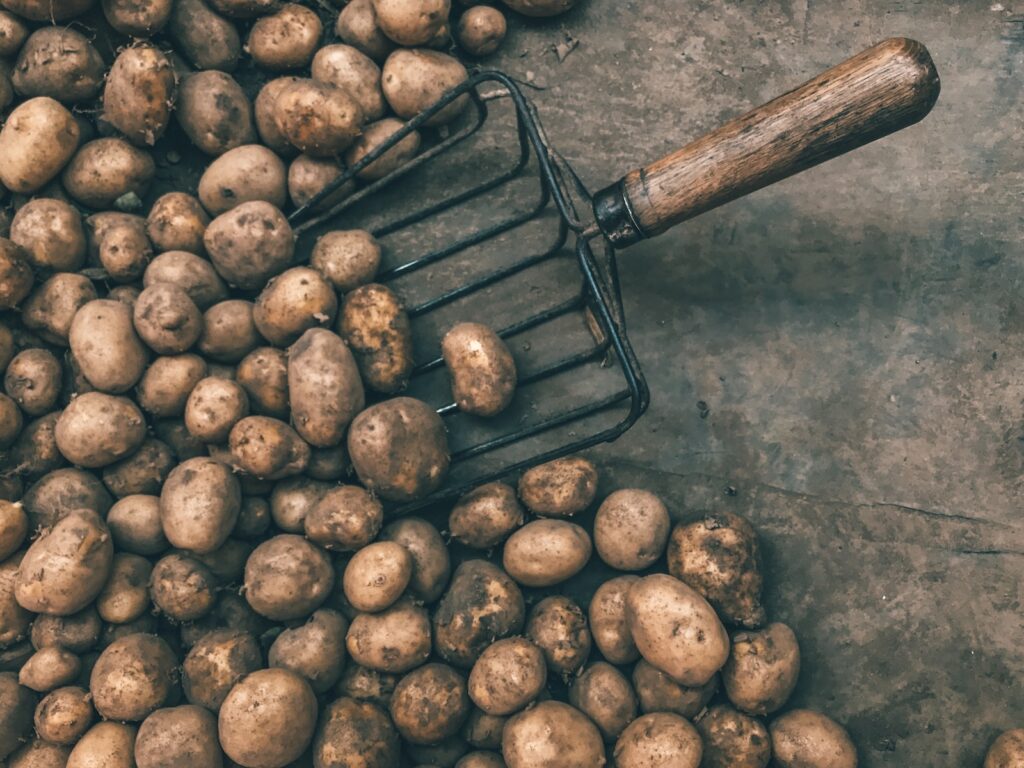
Potatoes come in many different varieties, each with its own unique characteristics and uses. Here are some of the most common potato varieties:
Russet Potatoes
Russet potatoes are a popular variety that are often used for making baked potatoes or French fries. They have a high starch content and a dry, fluffy texture when cooked. Russet potatoes are also good for mashing.
Red Potatoes
Red potatoes have a thin, smooth skin and a creamy texture when cooked. They are often used for making potato salad or roasted potatoes. Red potatoes are also good for boiling and mashing.
Yukon Gold Potatoes
Yukon Gold potatoes have a buttery, yellow flesh and a thin, delicate skin. They are often used for making mashed potatoes or roasted potatoes. Yukon Gold potatoes are also good for boiling and baking.
Fingerling Potatoes
Fingerling potatoes are small, thin potatoes that come in a variety of colors, including yellow, red, and purple. They have a firm, waxy texture and are often used for roasting or boiling. Fingerling potatoes are also good for making potato salad.
Overall, there are many different potato varieties to choose from, each with its own unique flavor and texture. Whether you prefer baked potatoes, mashed potatoes, or any other potato dish, there is a variety that will work well for you.
Potato Plant Care
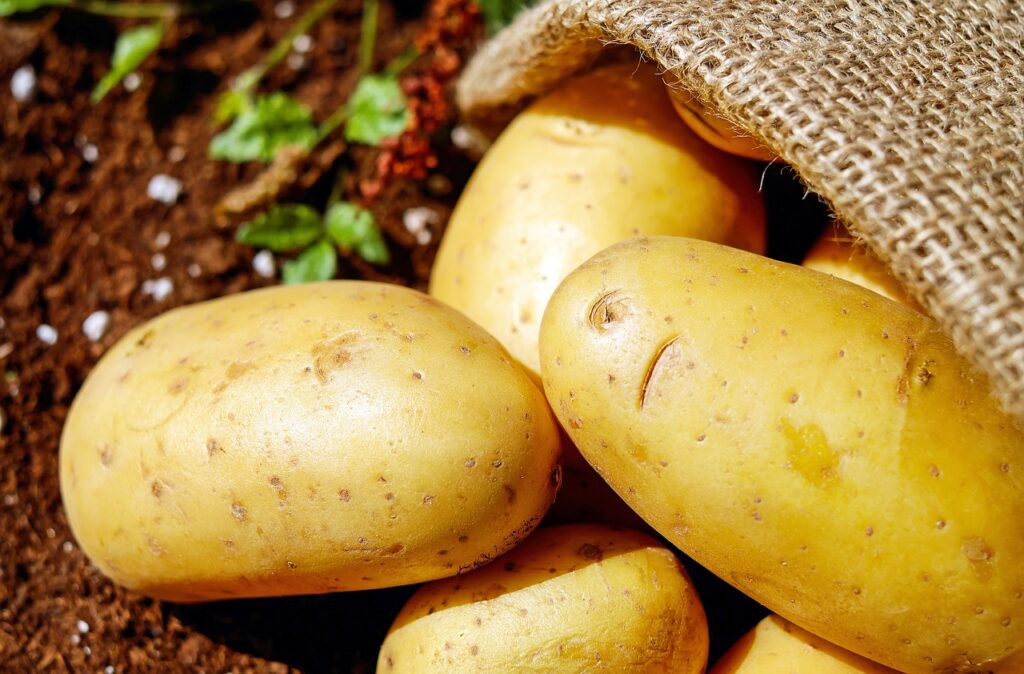
Soil and Temperature Conditions
Potatoes grow best in well-drained soil with a pH between 5.0 and 6.0. The ideal soil temperature for planting is between 60°F and 65°F. If the soil temperature is too cold, the seed potatoes may rot before they have a chance to sprout. If the soil is too warm, the potatoes may not grow properly and may develop hollow centers.
To improve soil quality, gardeners can add compost or well-rotted manure to their soil. This will help to increase the soil’s fertility and water-holding capacity. It is important to avoid planting potatoes in the same soil for two consecutive years, as this can lead to a buildup of pests and diseases.
Pest and Disease Management
Potatoes are susceptible to a variety of pests and diseases, including late blight, aphids, and nutrient deficiencies. To prevent these issues, it is important to practice good crop rotation and maintain healthy soil.
Late blight is a common disease that can devastate potato crops. It is caused by a fungus and can spread quickly in wet conditions. To prevent late blight, gardeners should plant disease-resistant potato varieties and avoid planting in areas where the disease has been present in the past.
Aphids are another common pest that can damage potato plants. These small insects feed on the plant’s sap and can stunt growth and reduce yields. To prevent aphids, gardeners can use insecticidal soap or introduce natural predators like ladybugs.
Overall, proper soil preparation and pest and disease management are essential for growing healthy and productive potato plants. By following these tips, gardeners can enjoy a bountiful harvest of delicious and nutritious potatoes.
Potato Planting Methods
In-Ground Planting
When planting potatoes in the ground, it’s important to choose a sunny location with well-draining soil. The soil should be loose and free of rocks, which can impede tuber growth. Before planting, mix in compost or well-rotted manure to improve soil fertility.
To plant, dig a trench about 6 inches deep and place seed potatoes (cut side down) about 12 inches apart. Cover the potatoes with soil and water well. As the plants grow, continue to mound soil around the stems to encourage tuber growth.
Container Planting
Growing potatoes in containers is a great option for those with limited space. Choose a container that is at least 16 inches deep and 16 inches wide, with drainage holes at the bottom. Fill the container with a well-draining potting mix and mix in some compost or well-rotted manure for added fertility.
Plant one or two seed potatoes in the container and cover with soil. As the plants grow, continue to add soil to the container to encourage tuber growth. Water the plants regularly and fertilize with a balanced fertilizer every two weeks.
Raised Bed Planting
Raised beds are a great option for growing potatoes, as they provide excellent drainage and aeration for the soil. Choose a location that receives full sun and has well-draining soil.
To plant, prepare the soil by mixing in compost or well-rotted manure. Plant seed potatoes about 12 inches apart and cover with soil. As the plants grow, continue to mound soil around the stems to encourage tuber growth.
Overall, potatoes can be grown in a variety of ways, including in the ground, containers, and raised beds. Each method has its own advantages and disadvantages, so choose the method that works best for your specific situation.
Producing Potatoes from Seeds
Potatoes are typically grown from seed potatoes, which are small potatoes that have been allowed to sprout. However, it is also possible to grow potatoes from true potato seeds (TPS). TPS are the seeds produced by potato plants, and they can be used to produce new potato plants.
Producing potatoes from TPS is a more complicated process than growing potatoes from seed potatoes. TPS are typically small and require careful handling to avoid damaging them. Additionally, not all TPS will produce viable potato plants, so it is important to select TPS carefully.
To produce potatoes from TPS, the seeds must first be germinated. This can be done by placing the seeds in a moist, warm environment for several days. Once the seeds have sprouted, they can be planted in soil.
It is important to note that TPS produce plants that are genetically diverse. This means that the resulting potato plants may not be identical to the parent plant. However, this diversity can also be an advantage, as it can lead to new and interesting potato varieties.
Overall, producing potatoes from TPS is a more challenging but rewarding process than growing potatoes from seed potatoes. With careful handling and selection, TPS can be used to produce new and interesting potato varieties.
Potato Plant in Encyclopaedia Britannica
Potato plant, (Solanum tuberosum), herbaceous perennial plant in the nightshade family (Solanaceae), grown for its starchy edible tubers. The potato is native to the Peruvian-Bolivian Andes and is one of the world’s main food crops.
The potato plant grows up to 2 feet (60 cm) tall and has compound leaves with leaflets that are ovate and dentate. The flowers are typically blue or white with yellow stamens. The potato plant produces tubers that vary in size and shape, with some being round and others elongated. The skin of the tuber can be white, yellow, brown, red, or purple, while the flesh can be white or yellow.
Potatoes are typically grown from seed potatoes, which are small tubers that are planted in the ground. The tubers sprout and grow into plants that produce new tubers. Potatoes are usually harvested in the fall, after the plants have died back. The tubers are then stored for later use.
Potatoes are an important source of carbohydrates and are used in a wide variety of dishes, including mashed potatoes, french fries, and potato chips. They are also used as a thickener in soups and stews. In addition to their culinary uses, potatoes are also used for industrial purposes, such as in the production of starch and alcohol.
Overall, the potato plant is an important crop that has been cultivated for thousands of years. Its versatility and nutritional value have made it a staple food in many parts of the world.